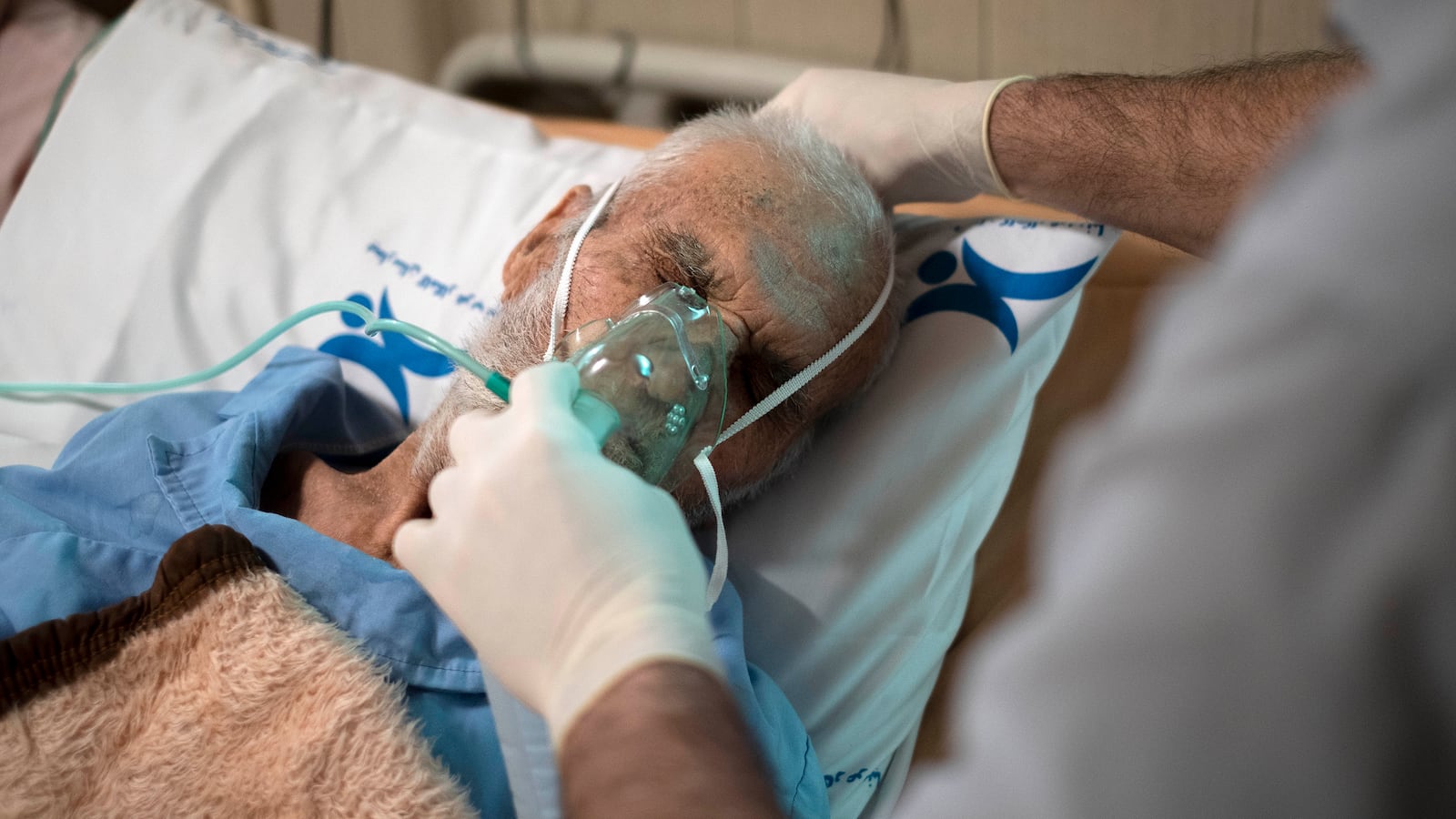After spreading across Asia and Europe, the BA.2 subvariant of the novel coronavirus is now dominant in the United States, according to the U.S. Centers for Disease Control and Prevention.
Right now, U.S. COVID cases are at a six-month low. But what happens next in the U.S. and nearby countries is hard to predict. Looking to Europe for hints isn’t enormously helpful because, on that continent, BA.2 has behaved… unpredictably. Indeed, unpredictability might be exactly what Americans—and everyone else—should expect as the pandemic enters its 28th month.
A patchwork of public health rules, varying vaccination rates, and differing amounts of natural immunity from past infections mean that no two countries are the same. But even those differences don’t fully explain BA.2’s uneven impact.
“The bottom line is that it is not predictable what BA.2 will do,” John Swartzberg, a professor emeritus of infectious diseases and vaccinology at the University of California-Berkeley’s School of Public Health, told The Daily Beast.
Amid this confusion, at least one thing remains true, however. As volatile as BA.2 is when it comes to countries and populations, you can still protect yourself by getting vaccinated.
Usually, there’s a pattern with new COVID lineages. An uptick in positive tests from clinics, hospitals, and wastewater samples correlates with a proportional increase in symptomatic infections.
But when it comes to BA.2, “something different seems to be occurring,” Peter Hotez, an expert in vaccine development at Baylor College, told The Daily Beast. “BA.2 is going up everywhere in terms of percentage of virus isolated” in tests, Hotez explained, “yet this translates into many different scenarios in terms of rise in cases.”
BA.2 is a highly mutated cousin of the previously dominant BA.1 subvariant of Omicron, the latest major variant—“lineage” is the scientific term–of the SARS-CoV-2 virus. Changes to the spike protein, which helps the virus to grab onto and infect our cells, make BA.1 and BA.2 extremely transmissible.
BA.1, which first appeared last fall and quickly drove record infections across much of the world, was the most contagious respiratory virus many virologists had ever seen—until BA.2 showed up a few weeks after its older cousin. BA.2 could be as much as 80 percent more transmissible than BA.1, Swartzberg said.

A health worker takes a swab sample from a man to be tested for COVID-19 at a testing site along a street in Beijing on March 15, 2022.
Jade Gao/AFP via GettyThat’s why BA.2 eventually has outcompeted BA.1 and become the dominant sublineage in a steadily growing number of countries. It happened first in China, which for more than two years managed to avoid major COVID outbreaks through a combination of travel restrictions, business closures, careful contact-tracing and strict quarantine rules.
BA.2 blew right through China’s so-called “zero-COVID” strategy, causing cases to spike in Hong Kong then neighboring Shenzen then Shanghai. Authorities locked down each city in turn but still failed to stop the sublineage’s march across the country.
Europe was next. Health officials in the Americas watched nervously as BA.2 became dominant in one European country after another. After all, Europe tends to catch a particular coronavirus lineage or sublineage a month or six weeks before the U.S. and its neighbors do.
But BA.2 hasn’t sent clear signals. The first confusing datapoint actually wasn’t in Europe—it was in Africa. Weirdly, BA.2 was a virtual no-show in South Africa. That country logged a big surge in BA.1 cases in December, and then… nothing. A steady decline in cases even as BA.2 was ravaging other big, rich countries.
Some European countries likewise have escaped significant harm from BA.2. Others are reeling.
The United Kingdom and France caught BA.1 big-time in December and January. Both countries reported record numbers of cases that, owing to the vaccines, fortunately didn’t lead to record hospitalizations and deaths. Austria, by contrast, muddled through BA.1 before taking a huge hit from BA.2.
The U.K. reported a weekly average of 183,000 new daily cases in early January. Three weeks later, France counted a staggering weekly average of 354,000 daily new cases. The U.K.’s worst day for BA.1 deaths was Feb. 2, when authorities reported 535 COVID fatalities. On France’s worst day of BA.1, Feb. 8, 691 people died of COVID.
Comparing the two countries is natural. Not only are they neighbors, they also have roughly the same number of people–around 67 million. Both have managed to fully vaccinate around three-quarters of their populations. Both have wound down all major domestic COVID restrictions.
It makes sense that BA.2 would affect France and the U.K. similarly. And there, at least, the sublineage made some sense. The BA.2 wave that rolled across the U.K. and France starting in February has been relatively minor compared to the BA.1 wave—in both countries.
France’s daily new BA.2 cases seem to be leveling off at a weekly average of 126,000 infections. The U.K.’s weekly average of daily new cases peaked at 125,000 on March 21. Deaths tend to lag cases by a few weeks, so it’s not clear how fatal BA.2 will be in either country, but so far the worst daily death toll is much lower than it was for BA.1.
Now consider Austria. With just 8.9 million people, it’s smaller than the U.K. and France. But it’s equally well-vaccinated—and even came close to having a nationwide vaccine mandate before canceling the planned mandate back in early March, days before it was due to take effect. Austria, like most countries in Europe, has ended domestic restrictions on businesses and travel.
But unlike the U.K. and France, Austria caught BA.2 worse than BA.1. Daily new case rates from BA.1 swelled to a weekly average of 34,000 and stayed there for a month and a half. Then BA.2 arrived in early March and, without much respite from BA.1, added another 10,000 daily new cases on top of the existing weekly average.
Aside from a tiny dip in mid-March, the daily death rate has been going up and up on a weekly basis since January in Austria. BA.2 is claiming 40 lives a day, day after day on average.
It’s difficult to determine which policies make the difference—assuming differences in public health strategy matter at all against a virus as contagious as BA.2. Yes, Austria almost had a vaccine mandate, but it didn’t actually take force. And it’s very hard to say what the proposed mandate’s impact was, or would have been.
“Even if no additional people got vaccinated after a mandate was introduced, this doesn't mean it didn’t ‘work,’ as the purpose of the mandate may have been to simply ensure that the only people you encounter when out at a restaurant or concert are vaccinated,” Maxwell Smith, a bioethicist at Western University in Ontario, told The Daily Beast.

A screen shows the number of new COVID-19 infections nationwide at a subway station on March 17, 2022, in Seoul, South Korea.
Chung Sung-Jun/Getty“In that case, the vaccination mandate ‘working’ would mean reducing levels of transmission of the virus in the settings to which it applied,” Smith added. “Or, in the case of preserving critical infrastructure, it would mean something like fewer cases of severe illness or hospitalizations among those to whom the mandate applied.”
There are lots of ways Austria’s vaccine mandate might have improved outcomes for millions of Austrians at risk of catching COVID. But that didn’t stop Austria as a whole from suffering worse from BA.2 than other nearby countries.
“There are many factors that may have led to the case numbers we're seeing both in Austria and its neighboring countries, so I can’t say with any certainty that this can be chalked up to their vaccine policies or vaccine politics alone,” Smith said.
Experts are at a loss to explain what other factors might be at work. If nearby countries have vaccinated roughly the same percentage of their populations and have also reopened their borders, businesses and schools—thus allowing for a certain level of natural immunity from past infection—then they should be equally prepared for a new viral lineage.
Clearly, they’re not. “I don’t see a consistent thread between countries,” Swartzberg said.
There are serious implications for the rest of the world as it braces for BA.2. Even strong vaccine uptake and lingering natural immunity might not spare you a big bump in infections. By the same token, BA.2 might just bypass a country for reasons no one fully understands, like it did with South Africa.
But the experiences of whole countries aren’t the experiences of individuals. Yes, BA.2 might have unpredictable effects on populations. But the science is clear on how people can reduce their personal risk. Favor well-ventilated indoor spaces. Wear an N95 mask when local case rates are high.
Most importantly, get vaccinated and boosted.








